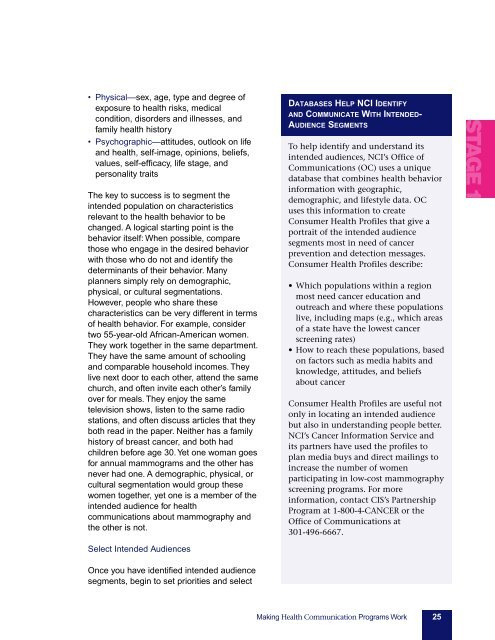pink-book
pink-book
pink-book
Create successful ePaper yourself
Turn your PDF publications into a flip-book with our unique Google optimized e-Paper software.
• Physical—sex, age, type and degree of<br />
exposure to health risks, medical<br />
condition, disorders and illnesses, and<br />
family health history<br />
• Psychographic—attitudes, outlook on life<br />
and health, self-image, opinions, beliefs,<br />
values, self-efficacy, life stage, and<br />
personality traits<br />
The key to success is to segment the<br />
intended population on characteristics<br />
relevant to the health behavior to be<br />
changed. A logical starting point is the<br />
behavior itself: When possible, compare<br />
those who engage in the desired behavior<br />
with those who do not and identify the<br />
determinants of their behavior. Many<br />
planners simply rely on demographic,<br />
physical, or cultural segmentations.<br />
However, people who share these<br />
characteristics can be very different in terms<br />
of health behavior. For example, consider<br />
two 55-year-old African-American women.<br />
They work together in the same department.<br />
They have the same amount of schooling<br />
and comparable household incomes. They<br />
live next door to each other, attend the same<br />
church, and often invite each other’s family<br />
over for meals. They enjoy the same<br />
television shows, listen to the same radio<br />
stations, and often discuss articles that they<br />
both read in the paper. Neither has a family<br />
history of breast cancer, and both had<br />
children before age 30. Yet one woman goes<br />
for annual mammograms and the other has<br />
never had one. A demographic, physical, or<br />
cultural segmentation would group these<br />
women together, yet one is a member of the<br />
intended audience for health<br />
communications about mammography and<br />
the other is not.<br />
Select Intended Audiences<br />
Once you have identified intended audience<br />
segments, begin to set priorities and select<br />
DATABASES HELP NCI IDENTIFY<br />
AND COMMUNICATE WITH INTENDED<br />
AUDIENCE SEGMENTS<br />
To help identify and understand its<br />
intended audiences, NCI’s Office of<br />
Communications (OC) uses a unique<br />
database that combines health behavior<br />
information with geographic,<br />
demographic, and lifestyle data. OC<br />
uses this information to create<br />
Consumer Health Profiles that give a<br />
portrait of the intended audience<br />
segments most in need of cancer<br />
prevention and detection messages.<br />
Consumer Health Profiles describe:<br />
• Which populations within a region<br />
most need cancer education and<br />
outreach and where these populations<br />
live, including maps (e.g., which areas<br />
of a state have the lowest cancer<br />
screening rates)<br />
• How to reach these populations, based<br />
on factors such as media habits and<br />
knowledge, attitudes, and beliefs<br />
about cancer<br />
Consumer Health Profiles are useful not<br />
only in locating an intended audience<br />
but also in understanding people better.<br />
NCI’s Cancer Information Service and<br />
its partners have used the profiles to<br />
plan media buys and direct mailings to<br />
increase the number of women<br />
participating in low-cost mammography<br />
screening programs. For more<br />
information, contact CIS’s Partnership<br />
Program at 1-800-4-CANCER or the<br />
Office of Communications at<br />
301-496-6667.<br />
STAGE 1<br />
Making Health Communication Programs Work 25


